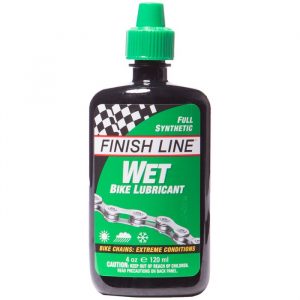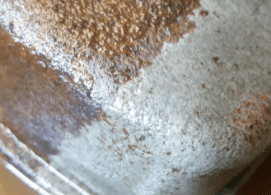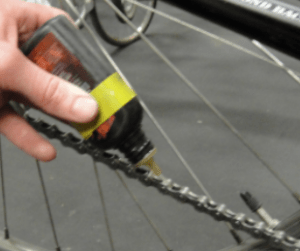Jim is an accomplished triathlete and endurance cyclist, and has raced in more than 35 USAT-certified races. He is also an avid trail runner and endurance gravel bike rider. Jim is a founder of Complete Tri and frequent writer on triathlon and cycling.
If you’ve ever owned a bike before, you’ll know how sad it can be to see your once-gorgeous looking bike turn into something rusty and old looking. Even a little patch of rust can randomly show up, creating some cause for concern.
Rust on bikes can be caused by many things, ranging from condensation during storage to your own sweat during rides!
Thankfully, most bike rust is simply superficial surface rust, and getting rid of rust from a bike isn’t as tricky as some might think. There is lots of bike maintenance you could do, and keeping the frame and components free of rust should be a regular, quick task on your checklist. It is possible to invest a lot of money into your bike, especially today’s road bikes, so you want it to look good and keep its value in case you ever decide to resell it. So, how should you go about removing rust from your bike?
There are actually many things you can find and use in a common household that will help you remove the rust. Let’s get into them.

Above All Else: Don’t Hurt the Bike!
It should go without saying, but take great care not to damage the frame or components of your bike. Removing a little surface rust is not worth scratching or compromising the bike’s finish. Be gentle, use any products only as directed, and think twice around trying to scrape or sand any rust off with a hard metal edge, unless you are prepared to do touch-up paint as well.
On Chains, Just Use Bike Chain Oil
If the rust you are concerned about is just on your chain, first try giving it a good oiling with a bike chain lube. (We give you several good options here). The combination of chain oil, a little wiping with a rag, and then some riding can off be enough to wear off the start of some surface rust.
The trick to oiling your chain is to be patient and put a drop on each link, followed by a wiping motion with a cloth. Do that on the entire chain, it will take some time. Many people think that the way to oil a chain is to just squirt oil all over it and then ride. The trick is to keep the chain lubed but not soaked, so you need to be a bit detailed.
There are also some chain lube options that are not as oily, but more of a paste or wax. These are good options for when you need to work indoors because you won’t have oily drips to contend with. We summarize bike chain pastes and wax in the same lube article.
Try this first if you have chain rust, and there is a good chance it will take care of the problem.
WD-40 for Bike Chains

WD-40 is truly a multi-purpose chemical, and we find it does well on bikes that have accumulated some rust. We always have it ready as an option, especially if working on a chain that needs some real TLC.
There are a couple schools of thought on WD-40 for bike chains, though. Some swear by it, others don’t like it.
The thing to keep in mind about WD-40 is that it is more of a cleaner, and not so much of a lubricant. So, it works great if you need to get some rust off of metal parts, especially if you are dealing mainly with surface rust. Just know that if you use it, perhaps on a chain, you will still want to lube the chain afterward with more of a classic chain lube or oil.
It’s not gonna hurt your bike chain. It just might not lubricate it for very many miles.
Baking Soda
The home-based method to remove rust from your bike is by using baking soda. Baking soda is perhaps the best way to remove rust from bikes because if done right, it is a mild cleaner and won’t damage anything. Baking soda works effectively on rust by forcing it to fade away quickly. Over time, your bike should return to its original condition if you use this method periodically. Here’s how you should use baking soda for minor and severe rust on your bike:
- Mixing Baking Soda and Water
- Grab and mix an equal amount of both baking soda and water in a bowl. There is no set amount you should use, eyeballing it should be fine. If your bike is heavily covered in rust, add a little more baking soda than water.
- Keep on mixing the two components together until it becomes a thick paste.
- Keep additional baking soda and water nearby in case you need more paste than you thought. You can also add a small amount of lemon juice to the baking soda paste to increase the strength of the mixture (for very bad rusting).
- Apply the Paste
Take the baking soda paste and apply it on the rusted areas of your bike. Apply the paste using a spatula or a similar tool such as a brush or sponge and press down directly on the affected areas. Leave the paste on for 15 minutes for maximum effectiveness. It’s important to keep the paste on for 10-15 minutes because it needs time to set in order to remove the rust.
- Remove the Baking Soda
Remember, the baking soda must be thick enough to cover the entire rusted areas. You’ll need to coat it properly without having it drip all over your bike or floor – if this happens, you know that the mixture wasn’t thick enough – mix some more!
Scrub or remove the baking soda from the bike using a sponge or scrub pads. You can also use a plastic scrubber or a toothbrush. As you start scrubbing, you will notice that the rust will start coming off, revealing what once was your beautiful bike. If you don’t see a change, you’ll need to redo the process with more baking soda or lemon juice.
Once you’re done with all of that, dry the bike completely to help prevent anymore rusting from happening. You should then store your bike in a dry place to also help prevent rusting.
Vinegar or Coca Cola

The second method to remove rust from your bike is by using vinegar or coca cola. Vinegar and coca cola work effectively on rust because they have a strong enough acetic property that’ll breakdown the rust. Here are some ways you can use vinegar or coca cola to remove rust from your bike:
- Spraying Your Bike
Wear some plastic gloves and grab a spray bottle and add some vinegar/coca cola into it. There is no exact amount to use, use your own judgement based on how big your bike is and how much rust there is. Now, simply spray the vinegar/coca cola over the rusty areas and use a toothbrush (or similar tool) covered in tinfoil to scrub the rust off. Using a spray bottle is great because it lets you quickly add more solution whenever you need it. If you see that the rust isn’t coming off, spray more solution and scrub harder!
- Adding Baking Soda
If you find that the rust isn’t coming off after putting in some scrubbing muscle, add a small amount of baking soda to your spray bottle. This is going to help react with your vinegar/coca cola to become a stronger solution that’ll help remove the rust from your bike. It’s important not to add too much baking soda as the solution may become too strong and damage your bike. Spray the solution on the rusty areas again and scrub away.
- Soak Bike Parts
A lazier way to get rid of the rust is by soaking all the rusty bike parts in your vinegar/coca cola solution. This method is going to require a lot more product than just spraying and scrubbing. After soaking your parts for 10 minutes, rinse your bike off thoroughly with water. If the solution stays on your bike for too long, it will eat or corrode the metal, completely ruining your bike. So remember, wash thoroughly!
Chemical Rust Remover
The third method to getting rid of rust from your bike is by using a powerful chemical rust remover (like Adam’s, here on Amazon.). The other home-based methods mentioned above will suffice for many people. However, if you want to have a well-stocked bike garage with built-for-purpose supplies, or are having real troubles removing the rust, then you should consider this method. Remember that if you decide to use this method, do not mix it with other solutions. Here’s how you should use a chemical rust remover that you can purchase at most department or hardware stores for your bike:
- Safety First
Whenever you work with chemicals, remember that they can be very dangerous. Always wear gloves and glasses before handling commercial chemical rust remover solutions. Read all the instructions carefully before handling it and if it is exposed to the skin or eye, wash it off immediately and seek medical attention. Use the remover in an open area and have a lot of airflow throughout the area.
- Application
Grab a brush and apply the remover on the rusted areas of your bike. Depending on the remover, you may need to leave it on for 30 minutes to an hour. Some removers may even require you to leave the solution on overnight! That’s why it’s important to read the instructions carefully so that you don’t damage your bike. If you’re looking for stronger and faster results, look for a remover that is highly potent.
- Removal and Aftercare
After the recommended time has passed, wipe the chemical rust remover off your bike using a cloth (you should still have gloves on) and then dispose of it to prevent it from contaminating anything else. Now, wash your bike thoroughly with warm water and then dry it completely. As always, store your bike away in a dry area.
Preventing Rust on Bikes
An ounce of prevention is worth a pound of cure. If you have rust developing on your bike, try to take steps to prevent it if at all possible. When it comes to surface rust developing on bikes, there are usually a few usual suspects. Combatting each can keep your bike more rust-free.
Store Your Bike Indoors
It’s great if you can store your bike in a climate-controlled area like the entry of your home or a HVAC-enabled garage. At a minimum, keep it in a shed or storage area that is out of the elements. All it takes is a bit of precip, and the bike will begin to develop surface rust on worn areas surprisingly fast!
Always Wipe Your Bike Down After Rain
If you had to ride your bike in the rain, or if you rode the morning after a rainstorm and the roads were still slick, get an old rag and give your bike a good, full wipe-down. Just make sure it is generally dry. Focus especially on any shiny parts — the chain, brake components, or other moveable pieces. Wiping a bike can be challenging when bent over, sucking wind after a long ride. Get a good bike stand, and do the work at counter-height. It makes a world of difference!
Keep Your Bike Oiled

Every bike owner should have bike oil within reach, and giving our bike a good lube should be something that you do routinely. Oil your chain, and any other components that move and are exposed to the elements. I even like to oil that spot where my pedal meets the crank. You want to oil the component and then wipe it down with a rag. Trust me, there will still be enough oil on it after wiping down to keep the rust away. A specific, built-for-cycling lube like tri-flow cycling oil can be all you need.
Beware of your own Sweat
Sometimes, it is the water dripping off of your body that can cause the rust, especially around the head, stem, and handlebar area where sweat from your face tends to drip. In fact, many avid indoor cyclist I know who put thousands of indoor miles on their bikes per year find that when they bring that bike in for service, it actually requires MORE work than their outside bikes…. because of all the corrosion from sweat salt.
If you are using an indoor bike trainer, this can be a particular problem because you are not actually in motion. Lay a towel over the bike’s stem area, it will do wonders to keep your salty sweat off the bike.
Clean your Bike After Hauling It
Highways are nasty, and the amount of salt, gravel, and grime that kicks up from your vehicle and other cars is considerable. If you take a long trip with your bike on a car bike rack, be sure to clean it off after, just so you don’t have any corrosive elements on your bike. This is even more important if you are using a trunk-based carrier like the Saris Bones, which tends to really leave your bike exposed to the elements.
Conclusion
These were some of the easiest ways to get rid of rust from your bike. After using these methods, we hope that your bike can return back to its original shiny form so that you can enjoy a smooth ride. We hope to see your bike is shining like a jewel on the road!








Good article. Speaking from unfortunate experience – do not use strong rust removers like naval jelly on any bike parts – the jell has a way of shattering spring steel. Since bikes use a lot of specialty steel I would not want to take a chance.
Wow – that’s a great heads up. I was about to take some naval jelly to the head tube on my steel steed.
Thank you for the great tips. I have three bikes I need to try it on. Hoping for good results!
Wow – that’s a great heads up. I was about to take some naval jelly to the head tube on my steel steed.
Thanks for your posting. My bike is full of rust. I need to get rid of it quickly. I hope this information will help me.
Rust can cause your bike to underperform and ruin your bike’s overall appearance. Thus, it is necessary to remove rust before it ruins your entire bicycle. You can use baking soda, WD-40, vinegar, and lubricants to keep your bike rust-free and shiny.